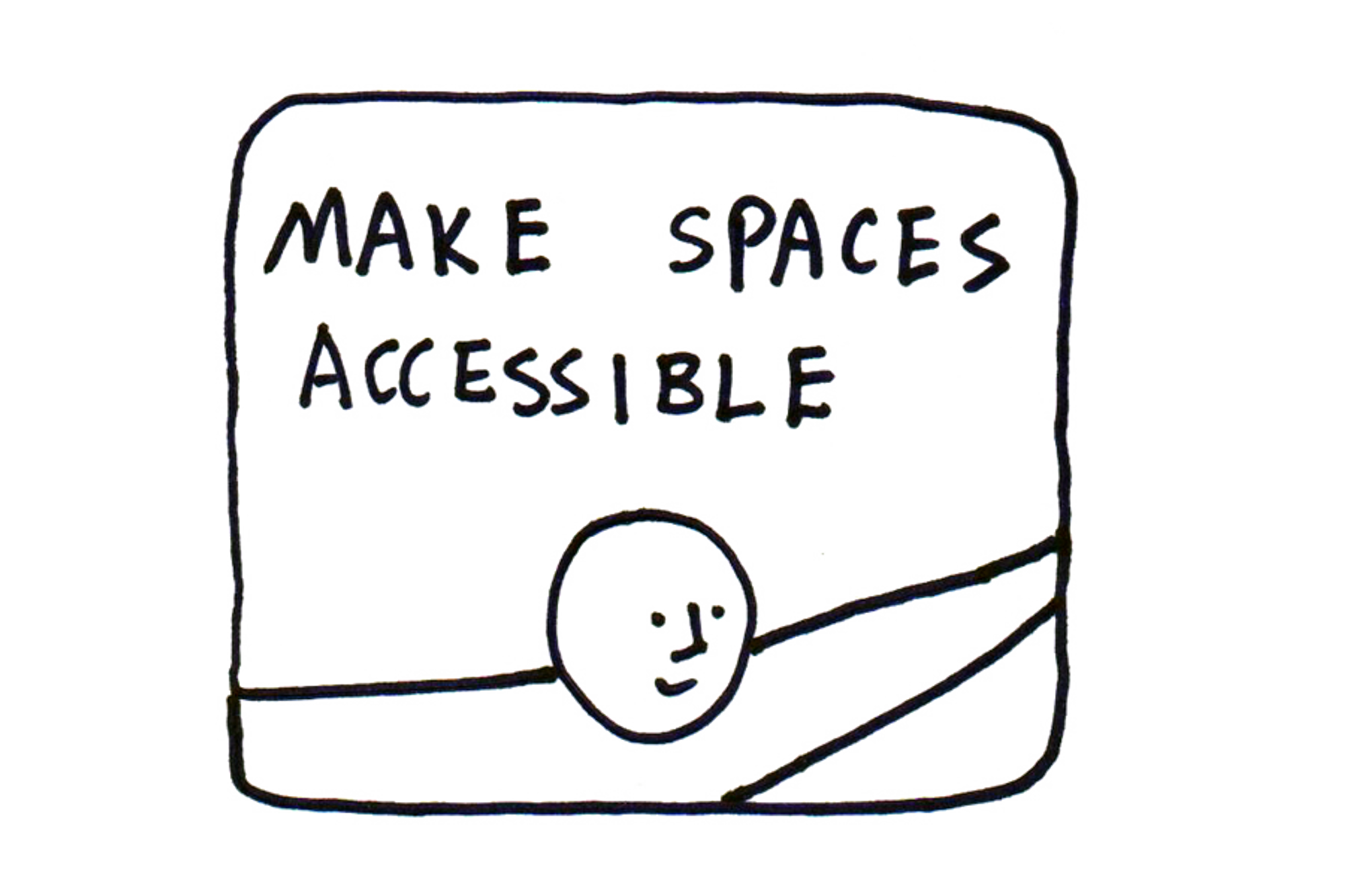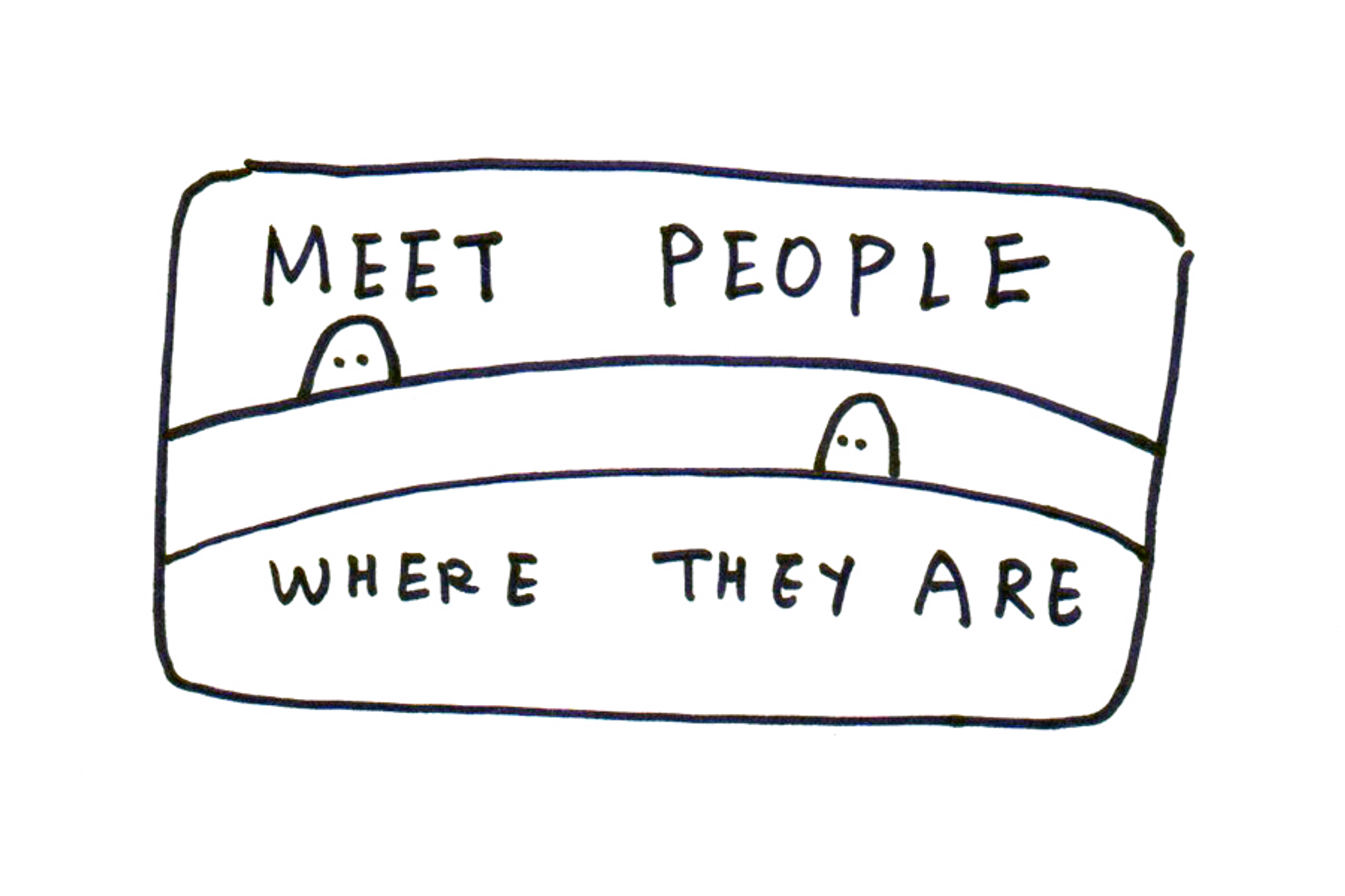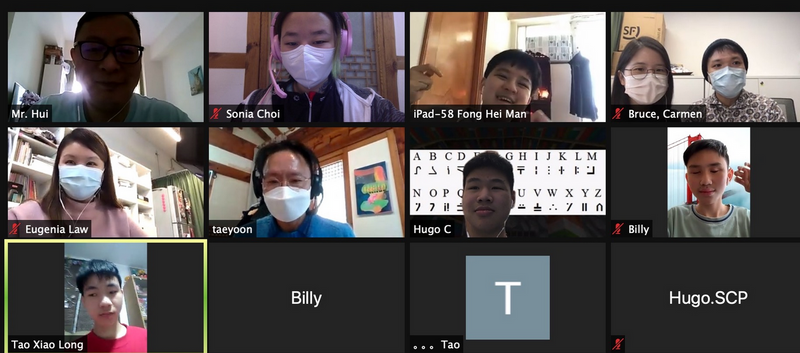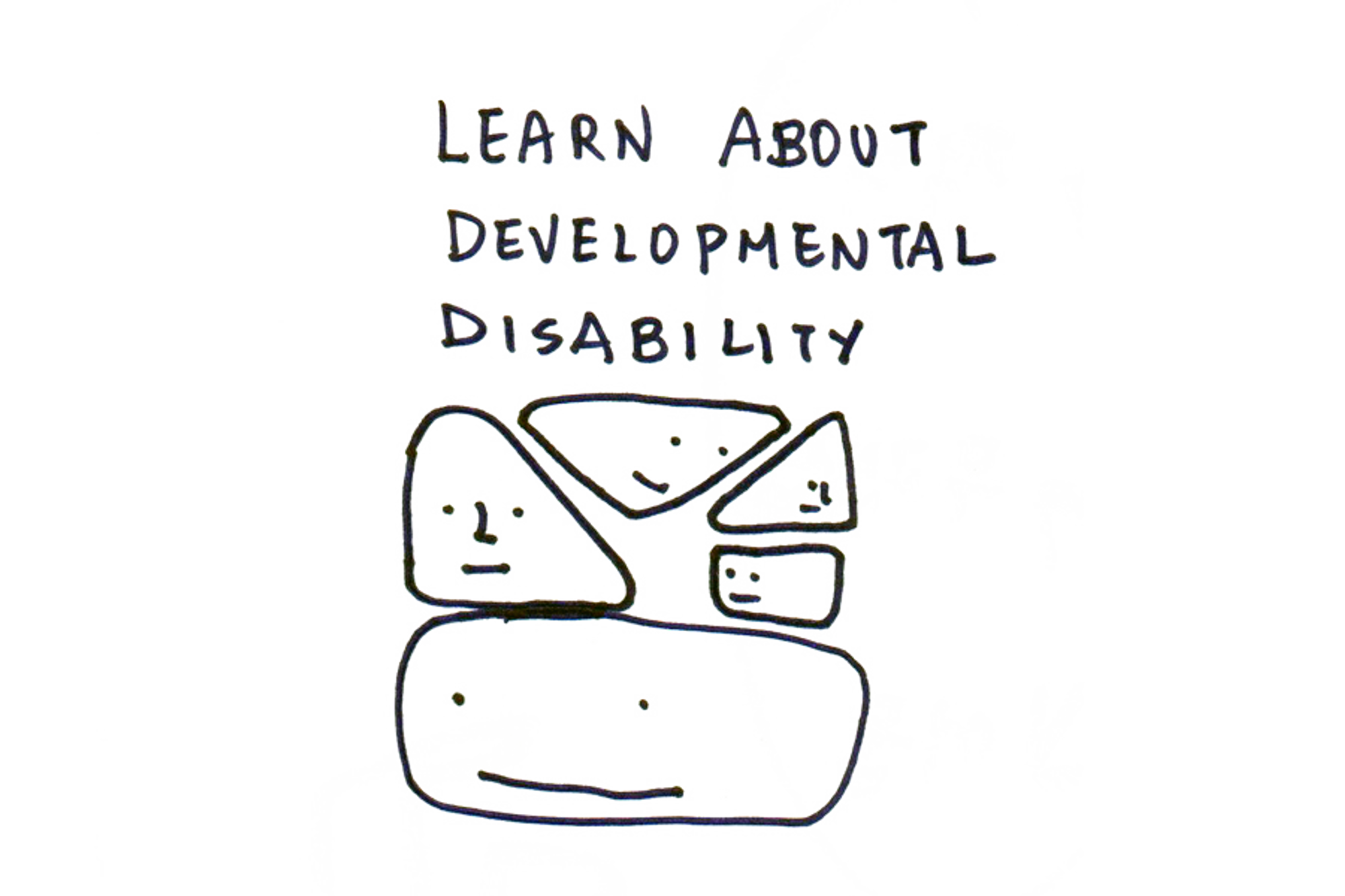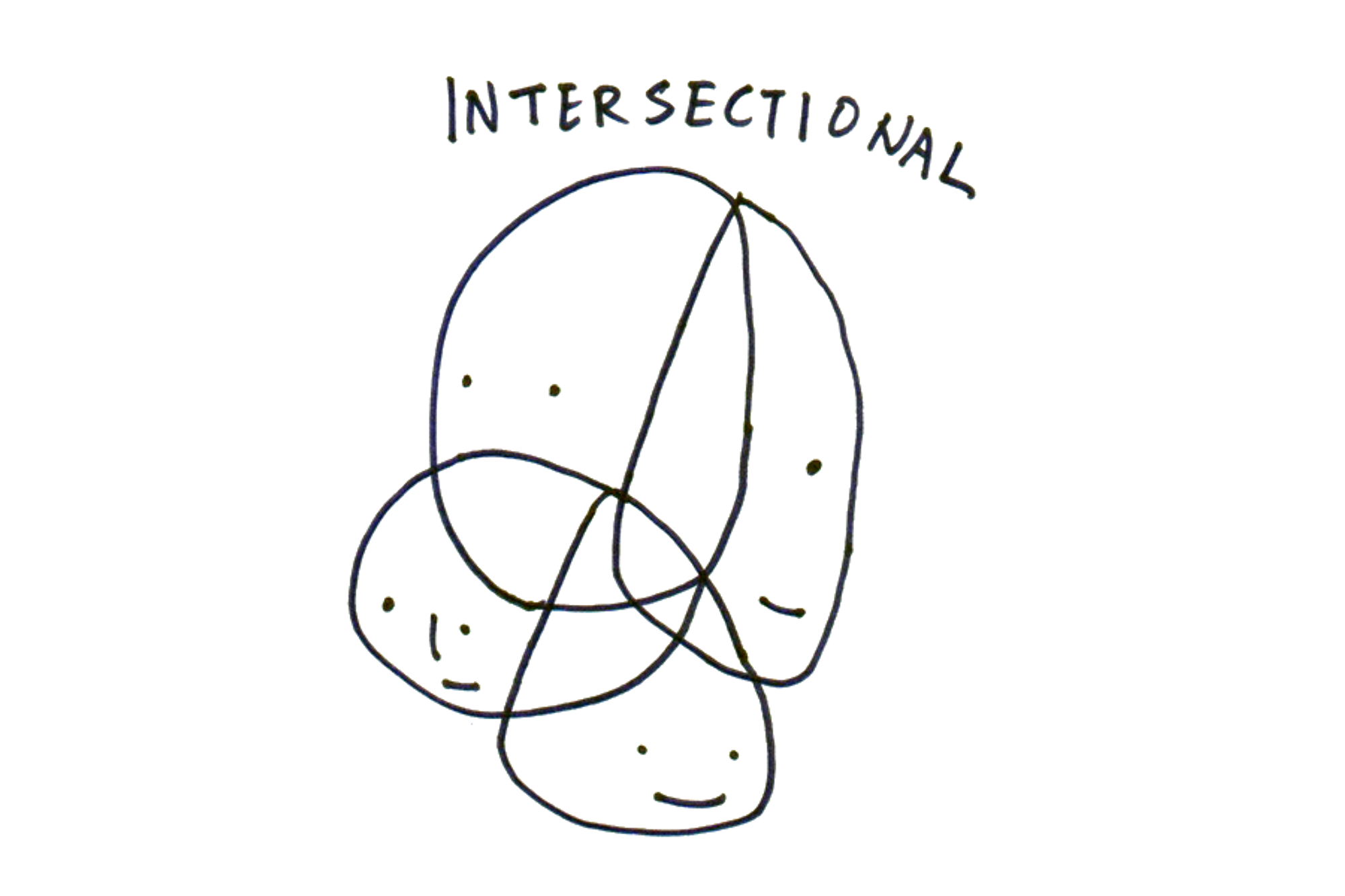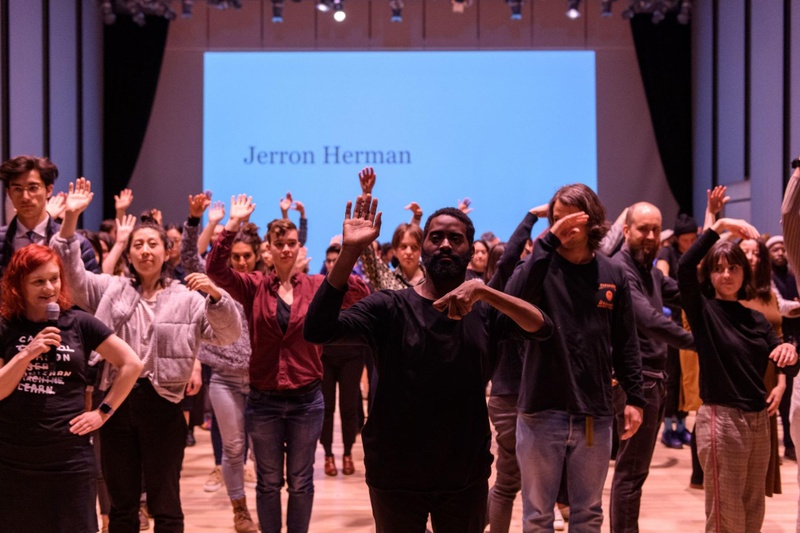A Guide for Co-Creating Access & Inclusion
I am a non-disabled person who works as an artist, educator, and organizer. Since 2015 I have worked closely with various disabled artists, curators, and organizers to develop exhibitions, performances, and workshops in North America and East Asia. Due to the nature of my work, I sometimes get questions from other non-disabled cultural workers about how they, too, can work with the disability community. I understand where they’re coming from—they want to do their best to support disabled people, but they’re nervous because they’re not sure exactly how to do so.
This guide is part of our series with Pioneer Works. For a deeper exploration of the topics covered below, read an interview between Taeyoon Choi and editor Willa Köerner on the Pioneer Works Broadcast.
Taeyoon Choi, Jerron Herman and DWC stewards, Distributed Web of Care, Whitney Museum of American Art, 2019. Photo by Filip Wolak.
This guide is for people who are considering working with and for disabled people, perhaps for the very first time. It includes a brief introduction to disability justice, and then focuses on artistic and pedagogical work with the disability community. Overall, I am writing this to share what I have discovered in conversation with many partners and community members. It is not intended to be fully representative of all access needs and cultural differences, and since I myself am a non-disabled person, it unfortunately includes my biases and misunderstandings about disability. With that in mind, I welcome criticism and feedback from the disability community to improve this guide. Please also note that in this guide, I use the terms “disabled person/people” and “disability community” instead of people-first terms (such as “person with disability”) which are sometimes considered to be more politically correct. My decision is influenced by disability activists and artists who take pride in their political and cultural identity as a “disabled person.” I am also using “Deaf person” with a capital D in respect to the Deaf culture.
Before we dive in, I want to express my gratitude to my friends—namely Christine Sun Kim, Jerron Herman, Alice Sheppard, Sara Hendren, Chancey Fleet, Eliza Chandler, Mara Mills, Shannon Finnegan, and Nic Annette Miller —whose practices and dedication to the disability community grounded my interest in this topic. I also want to express my thanks to Access Programs team at the Whitney Museum of American Art and to the Open Society Foundation Human Rights Initiative, which enabled and supported this work, Jaemin Shin and Suhyun Choi, who assisted me in a variety of projects from 2020-2021 and wrote a significant portion of the guide.
Step 1: Make Sure Your Spaces and Programming are Accessible
Enhancing Accessibility is good for everyone. 15% of the world’s population have disabilities, according to the World Bank report. Ensuring the participation of disabled people in your events gives access to a wider audience and perspective.
If you are planning to host an event in a physical space, consider working with a local Accessibility Consultant. They can help plan the layout of your venue and make sure the participants’ access needs are met. If you can’t hire someone, you can instead learn how to create accessible spaces from online resources such as ArtsEverwhere’s Access Guide.
As you begin to plan any event, it’s important to center the access needs of participants. A great way to do this is to ask the event participants about their access needs in advance, so that you’re able to provide exactly what they need—such as sign language interpretation, real time captioning, tactile materials, a ramp, a van, parking, etc. Examples of participants’ needs could include a preference for fragrance-free soaps in the venue, written image descriptions for visual materials, or private resting areas where participants can take breaks between programs. I’ve also worked with people who have a sensitive reaction to loud sounds, and have asked the organizers to avoid clapping. All this to say, you won’t know people’s unique needs unless you ask.
Accessible design takes into account the various ways humans exist, and helps disabled and non-disabled people alike in entering and participating in spaces. For further info on what this looks like, I recommend watching the video Why Is Accessible Design Good for Everyone? and reading the curriculum Creating Access & Universal Design from the Disability Resource Center at the University of Arizona.
As a last note, I want to confront the misconception that accessibility is expensive. It can feel expensive because professional services such as sign language interpretation are not often considered in an event’s original budget, and then must be added on as an extra expense. To avoid this, I recommend estimating the costs of accessibility services early on, and factoring them into the budget from the beginning. It’s important to respect the work of accessibility consultants and sign language interpreters, and pay them professional rates. However, if you are working in a more DIY venue with little or no funding, you can learn from the wisdom of QTBIPOC disabled low-income folks who have published examples on how to create accessible spaces through grassroots organizing. Making Space Accessible is An Act Of Love for Our Communities by Leah Lakshmi Piepzna-Samarasinha is a great place to start.
Step 2: Co-Create a Code of Conduct
A code of conduct is a piece of writing that articulates your values and approaches to creating a safe environment for everyone. By co-creating a code of conduct with your community and event participants, you’ll be developing a tool to lessen harm in your space, and establishing a shared understanding of how to constructively communicate and build a culture of consent and accountability.
As you co-create the code of conduct, it’s important to recognize the intersecting systemic structures that aggravate and produce the conditions of oppression and marginalization for disability communities. To start a generative conversation, you can pose an open-ended question, such as, “How do we love and care for each other in an ableist world?”
Here are a few example Code of Conduct documents you can reference as you work with your community to make your own:
- Sins Invalid’s 10 Principles of Disability Justice
- BUFU’s Cloud 9 Community Guidelines
- Allied Media Conference’s How to Virtual AMC
Step 3: Meet People Where They Are
As you prepare to welcome the disability community into your space and programming, it’s important to take steps to educate yourself. This means:
Learn about disability. A good place to start is to read What is Disability Justice? from Sins Invalid, or to watch Crip Camp: A Disability Revolution, which depicts the disability rights movement in the U.S.
Respect people’s identities. Ask, don’t assume. This phrase is borrowed from BUFU’s Cloud 9 Community Guidelines, and underscores how important it is to be sensitive to everyone’s individual identities and preferred gender pronouns. Even if someone has the same disability as another person, recognize that it doesn’t necessarily mean that they will want the same things. Everyone has a different relationship to their disability identity.
Learn what ableist language looks like, and avoid using it. Refer to Avoiding Ableist Language from Augsburg University and Disability Language Style Guide from the National Center on Disability and Journalism. Unless you are a disabled person reclaiming certain words for your own empowerment (for example, crip), always avoid using ableist language.
Respect people’s preferred languages. Do not assume everyone will speak and read English. Provide translation and interpretation when necessary.
Check in with people regularly. A simple “How are you feeling?” can go a long way. If someone seems like they’re having a hard time, asking “How can I support you?” or “What do you need?” can help them feel seen and cared for. In Care Work, Leah Lakshmi Piepzna Samarasinha suggests a more poetic inquiry: “What feels possible today?”
Check in with yourself. How are you feeling? What feels possible for you today? If supporting others isn’t within your capacity, turn your attention inwards. Burn-out is a result of ableist culture, and the care we show ourselves creates the groundwork for a caring world. These messages are borrowed from Mia Mingus.
Step 4: Learn About Blindness and Low Vision
To start, make a list of any visual elements in your space or events, and consider how you can make those aspects accessible. Here are some tips:
Taeyoon Choi, Poetic Coding Workshop, Ebenezer School and Home for the Visually Impaired and Centre for Heritage, Arts and Textile (CHAT) Hong Kong, 2021
Make Interactions Accessible
-
Introduce yourself with a visual description. When I introduce myself to a group of blind people, I say, “My name is Taeyoon, pronounced /tejun/. I’m a Korean American. I’m 5.6 feet tall. I wear glasses. My hair color is black, and I have a bun. Today, I’m wearing a black T-shirt. It’s nice to meet you all.” You can add a bit of humor and personality in the introduction.
-
Do not make unconsented physical contact. Blind people (and disabled people at large) are more likely to experience unconsented physical contact in public and private spaces, and such experiences can lead to trauma. Do not think you can be helpful by holding the hands or arms of a blind person. Unless the person explicitly asks for physical contact, do not engage in physical contact.
-
Don’t gesture, always verbalize. Non-disabled people communicate with body language, even when they’re not aware of it—so always try to be aware of how you’re communicating. For example, instead of saying, “Go over there” while pointing in that direction, specifically say something like, “Take three steps to your right.”
- Always use names. Instead of saying “Hey you,” call people by their names to get their attention. This isn’t just to show that you remember their name—it’s also because blind people may not realize you are calling them if you don’t clearly call out their name.
-
Avoid asking if a blind person can see something. Refer to 10 Tips for Teaching Blind or Visually Impaired Students.
- Know that it’s okay to use words that reference sight. For example, it’s okay to say “see you later!” These words are part of a blind or low-vision person’s vocabulary and they connote how they see the world—whether by touch, bringing things close, or in conversation.
Make Technology Accessible
-
Ensure that information is accessible for people with low vision. When creating visual materials, use a legible and large font size. For our workshop for the Ebenezer School and Home for the Blind and Visually Impaired in Hong Kong, we used font size 40-60 for print and digital materials. However, font size needs can vary by person. For materials printed with color, make sure that there is high contrast. Some places may have access to braille printers or capsule paper, although in my experience, many blind and low-vision participants prefer to use digital devices with screen-readers. Consult with the participants and people who work at the venue about what is preferred and what can be provided.
-
Make digital materials accessible. When creating a website for blind/low-vision communities, make sure you include Alt-Text (alternative text) to make visual information more accessible for people who use screen readers. For more info on this, refer to Alt-Text as Poetry by Shannon Finnegan. For any visual materials, take the time to describe the images specifically. Instead of writing one line such as, “There is a mountain with a blue sky,” write something more descriptive and expressive such as, “The sky is a clear blue, with no clouds. The mountain is white at its peak, and dark blue below. The mountain zig-zags across the horizon, forming three peaks. These mountains can be found in British Columbia, Canada.”
-
Make websites easy to navigate. With written content, always use HTML headers to break up your content. Headers allow people who use screen readers to jump between sections so that they can access specific materials with ease, without having to manually go through each paragraph.
ASL interpreter Denise Kahler, Artist Tiri Kananuruk, Distributed Web of Care, Whitney Museum of American Art, 2019. Photo by Filip Wolak.
Step 5: Learn About Deaf Culture and Sign Language
-
Make events accessible to the Deaf community. For classes, workshops, and presentations, provide CART (Communication Access Real Time Translation) and Sign Language Interpretation. Make sure presenters speak punctually, so that the interpreter has time to catch up, and so that Deaf people have enough time to see the caption/interpretation along with any other visual materials. If possible, give interpreters the materials in advance, so that they have time to prepare. This is especially important for jargon and technical terms that may need time to interpret.
-
Understand the varieties of sign languages. It is estimated there are about three hundred sign languages in use around the world today. When inviting a Deaf and Hard of Hearing person, ask which type of sign language interpretation they prefer.
-
Make videos accessible. Make sure videos have captions or sign language interpretation. If you are creating the video yourself and captioning it, refer to Christine Sun Kim’s rewrite of closed captions.
Step 6: Learn about Developmental Disability
-
Give people more time. Be patient and respect the way different people experience time. Consider that everyone’s sense of time is relational, and everyone’s individual pace is different. For some people, a 10-minutes break between programs may be enough, but other people may need 15 minutes or longer. As you schedule your event, leave time for breaks and scheduled check-ins to address everyone’s needs.
-
Give families space. Always respect individual family dynamics. While one disabled person may prefer to be near their family member in public, another disabled person may prefer to have some distance from their family member.
Audience interacting with software created by Jonathan Dahan, Cezar Mocan, Yehwan Song, Distributed Web of Care, Whitney Museum of American Art, 2019. Photo by Filip Wolak.
Step 7: Always Use Consentful Technology & Respect Privacy
In your space and events, the use of technology should always aim to support disabled people’s self-determination rather than creating barriers or diminishing someone’s capacity. As I wrote in Artificial Advancement, “Technological innovation is not an inherent good for disabled people, especially when the focus is on cure over care.” Make sure that the goal of using technology is to support access and inclusivity, rather than undermine it.
With that in mind, think through the following when integrating technology into your space/event:
-
Use software, applications, and hardware that people are already used to. Beyond this, take time to learn how folks with disabilities tend to navigate any software/hardware you’re planning to use. For further advice, refer to the Consentful Tech Project.
-
Be prepared for technical challenges and failures. These can be addressed before an event with a run-through. However, if technical failures still come up, try to go with the flow and improvise—while keeping things as accessible as possible.
-
Respect disabled people’s privacy. It’s important to give people the option to have a virtual background or to keep their cameras off to respect their privacy. Also, everyone comes from different socio-economic backgrounds and everyone may not feel comfortable sharing the environment of their home online.
-
Help people feel prepared. Make sure to send all materials such as the syllabus, worksheets, capsule paper, tactile materials, and any other event materials in advance (either in the mail, or over email) so that people can familiarize themselves with everything before the event.
-
Be open to all types of experiences. Different people may act or engage differently based on their needs. There may be different contingencies due to the domestic space, such as interruptions from family members. Keep this in mind and do not expect all people to give their full attention.
Step 8: Learn About the Intersectionalities of Disability
As a first step, Read Sins Invalid’s 10 principles of disability justice to learn about how disability intersects with racism, classism, sexism, homophobia, transphobia, and climate catastrophe. People become disabled as there is more violence in the world (wars, famine, sexual and domestic violence, intergenerational trauma, environmental racism, lack of access to resources, biological warfare, dangerous work conditions, the list goes on). Capitalism, heteropatriarchy, and white supremacy create the conditions for violence to exist, aggravating, producing and reproducing disability and ableism.
To learn more about the intersectionalities of disability, reference these people/resources:
- Leah Lakshmi-Piepzna Samarasinha
- Mia Mingus
- Leroy F. Moore Jr.
- QTPOC mental health
- Rebirth Garments by Sky Cubacub
- Disability Visibility Project by Alice Wong
- Black Disability Collective
- Harriet’s Apothecary
- Sisters Circle Collective
Dancer/Choreographer Jerron Herman leading a group of audience. Artist Lori Hepner narrating a visual interpretation of Jerron’s movement for the blind audience. Distributed Web of Care, Whitney Museum of American Art, 2019. Photo by Filip Wolak.
Step 9: Acknowledge and Undo Bias
As you learn more about disability, be open to correcting yourself and editing preconceived notions of disability, race, gender, class, and other identity markers you may have consciously or unconsciously internalized. In the case that you spot yourself or other people discriminating against someone, hold yourself and each other accountable. When you make a mistake, you can move on by correcting yourself, apologizing, and working to transform that behavior. If someone else makes a mistake, correct them in a respectful way. This necessitates that you do not shame each other or yourself, as shame is an obstacle to accountability.
As you take steps to unlearn biases, conflict, miscommunication, and hurt may be inevitable. Having a common understanding of systemic and interpersonal ways people are hurt or harmed—while working to transform the root causes of these things—requires you to be in an honest and genuine relationship with those you are working with. It’s also important to be aware that any type of accountability process you create can pose a risk of silencing or harming people who are already marginalized.
It’s helpful to refer to Mia Mingus’ Four Parts of Accountability: How to Give a Genuine Apology to address conflict, hurt, misunderstandings, small breaks in trust, and low-level harm. Over time, learning to address these smaller hurts will build the foundation to address larger degrees of harm should they arise.
Step 10: Work Collaboratively & Support Self-Determination
Make it a long-term habit to support the curiosity and self-determination of disabled people. Ask them what their interests are, and what they want to learn. Then, collaborate with them to create programming and spaces that are welcoming. Keep in mind all of the points covered in this guide to create meaningful and trusting relationships, rather than transactional or extractive ones.
Overall, remember that disabled people are all around us—they are our friends, our classmates, our neighbors, and our family. As you further your work with the disability community, ask yourself, “How do I understand disability? How can I expand my understanding to visiblize the people who may be disabled in their daily lives? How do I hold space for them in ways I haven’t before?”
Additional Context for This Guide
In creating this guide, we have been inspired by the work of Sins Invalid, Mia Mingus, Leah Lakshmi Piepzna-Samarasinha, the Disability Justice collective, and other QTBIPOC disabled leaders who have created and/or articulated the Disability Justice Framework. “Disability Justice’’ was coined by Patricia Berne, Leroy F. Moore Jr., Sins Invalid, and the Disability Justice collective (all QTBIPOC leaders). It was started by people who were tired of being marginalized and excluded from the disability movement in the U.S.
Although very important, Disability Studies and the Disability Rights movement do not inherently centralize the needs and experiences of folks experiencing intersectional oppression—such as disabled BIPOC, immigrants, queer, trans, and gender non-conforming people, homeless, incarcerated folks, and sex workers, among others. Disability Justice deals with the oppression of disability as it intersects with other systems of oppression and injustice by moving beyond rights and equality-based approaches, and instead works towards collective justice and liberation through the transformation of society as a whole.
Through this guide, we hope to inspire “Access Intimacy,” a concept from Mia Mingus which she describes as “a feeling you get in a place where you feel that all your access needs are being met.” Inclusive, accessible spaces and events should aspire to make people feel completely comfortable asking for help without shame or fear of rejection—all while knowing full well that they will receive the support they need. Access Intimacy is something that can transform ordinary access into a tool for liberation, instead of merely reinforcing inclusion and equality. Access for the sake of access or inclusion is not necessarily liberatory, but access done in the service of love, justice, connection, and community is liberatory, and has the power to transform.
Lastly, we believe in “moving at the speed of trust,” an expression from a lecture by Leah Lakshmi Piepzna-Samarasinha and Elliott Fukui that underscores the need to trust in ourselves and in disability communities, as well as the need for disabled people to trust in us and in themselves. Overall, the most important thing to remember is that no matter what event or space you are creating, it should ultimately bring joy and fulfillment to disabled people. As we work towards this goal, we must take the time to build meaningful relationships with each other, rather than transactional or outcome-focused relationships. In the long run, success will be defined by the quality of our relationships and the trust that is built over time.
Taeyoon Choi is an artist who works with drawing, painting, computer programming, performance and video.


